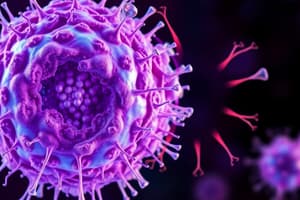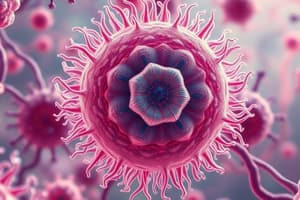Podcast
Questions and Answers
Which of the following best describes the primary role of the plasma membrane in a cell?
Which of the following best describes the primary role of the plasma membrane in a cell?
- Synthesizing proteins for use within the cell.
- Storing the cell's genetic material.
- Generating energy through cellular respiration.
- Controlling the movement of substances into and out of the cell. (correct)
How do the rough endoplasmic reticulum (RER) and smooth endoplasmic reticulum (SER) differ in function?
How do the rough endoplasmic reticulum (RER) and smooth endoplasmic reticulum (SER) differ in function?
- RER contains ribosomes and is involved in protein synthesis, while SER lacks ribosomes and is involved in lipid synthesis. (correct)
- RER processes and packages proteins, while SER transports proteins.
- RER is involved in detoxification, while SER is involved in protein folding.
- RER synthesizes lipids, while SER synthesizes proteins.
A cell is observed to have a nucleus, mitochondria, and endoplasmic reticulum. Based on these characteristics, how should it be classified?
A cell is observed to have a nucleus, mitochondria, and endoplasmic reticulum. Based on these characteristics, how should it be classified?
- As a primitive cell type lacking complex organelles.
- As a viral particle, capable of infecting other cells.
- As a prokaryotic cell, belonging to either Bacteria or Archaea.
- As a eukaryotic cell, belonging to the domain Eukarya. (correct)
After being synthesized in the endoplasmic reticulum, a protein needs further modification and packaging before being sent to its final destination. Which organelle is responsible for this process?
After being synthesized in the endoplasmic reticulum, a protein needs further modification and packaging before being sent to its final destination. Which organelle is responsible for this process?
What is the role of the nuclear envelope in eukaryotic cells?
What is the role of the nuclear envelope in eukaryotic cells?
How do gap junctions facilitate intercellular communication?
How do gap junctions facilitate intercellular communication?
If a cell were treated with a drug that inhibits the function of lysosomes, which cellular process would be most directly affected?
If a cell were treated with a drug that inhibits the function of lysosomes, which cellular process would be most directly affected?
Which of the following accurately describes the roles of both microtubules and actin filaments in a cell?
Which of the following accurately describes the roles of both microtubules and actin filaments in a cell?
During which phase of the cell cycle does DNA replication occur?
During which phase of the cell cycle does DNA replication occur?
How do embryonic stem cells differ from adult stem cells in terms of their differentiation potential?
How do embryonic stem cells differ from adult stem cells in terms of their differentiation potential?
Flashcards
Cell Biology
Cell Biology
The study of cells, including their structure, function, and behavior.
Cell Theory
Cell Theory
All living things are made of cells, cells are the basic unit of life, and all cells come from other cells.
Prokaryotic Cells
Prokaryotic Cells
Cells without a nucleus or other membrane-bound organelles.
Plasma Membrane
Plasma Membrane
Signup and view all the flashcards
Nucleus
Nucleus
Signup and view all the flashcards
Mitochondria
Mitochondria
Signup and view all the flashcards
Cytoskeleton
Cytoskeleton
Signup and view all the flashcards
Cell Cycle
Cell Cycle
Signup and view all the flashcards
Extracellular Matrix (ECM)
Extracellular Matrix (ECM)
Signup and view all the flashcards
Cell Differentiation
Cell Differentiation
Signup and view all the flashcards
Study Notes
The provided text is identical to the existing notes. No updates are needed.
Studying That Suits You
Use AI to generate personalized quizzes and flashcards to suit your learning preferences.




